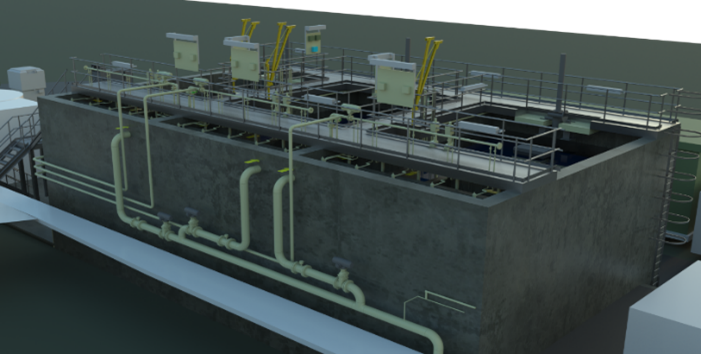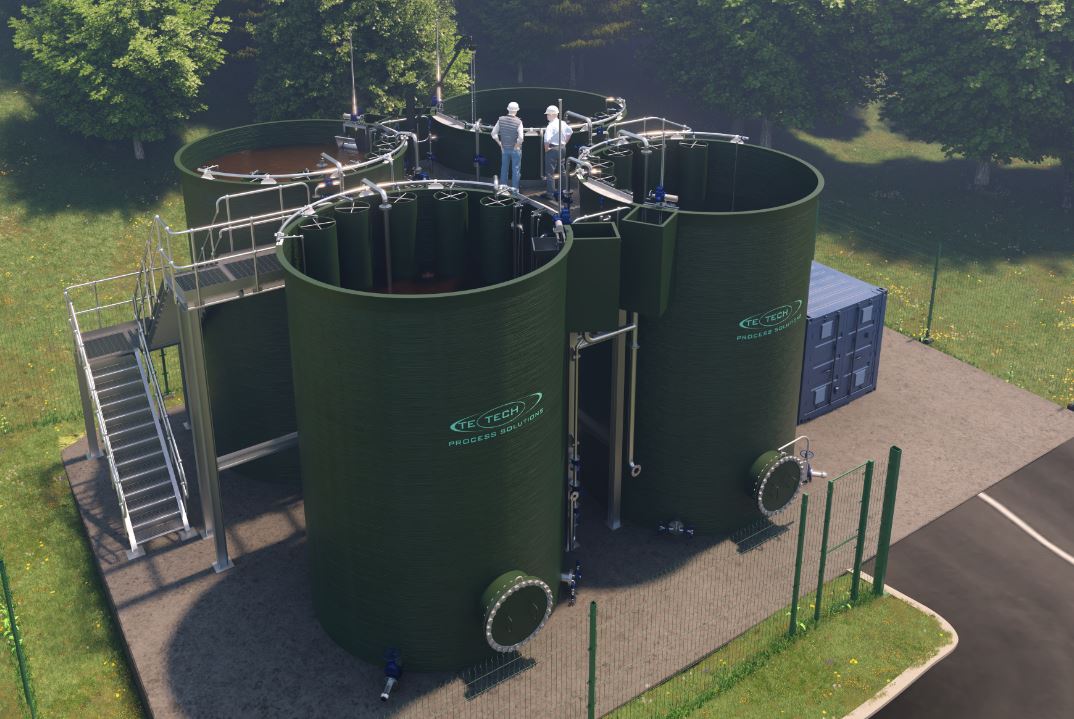Q1. Does the process require tertiary treatment for solids capture?
The te-cycTM process is particularly effective for the removal of suspended solids and does not require a separate solids capture or tertiary treatment stage.
The suspended solids in the effluent typically reach values below 5 mg/l on average. This means that even in plants with very strict phosphorus effluent values no further post-treatment is necessary.
Q2. Is the process limited or affected by changes in flow rate or storm conditions, can it accommodate higher peak flows?
Higher peak flows are not a problem at all for te-cycTM process for the following reasons:
1) Hydraulics are usually not related to loads. In the case of peak flows due to wet weather, the concentration of pollutants will be diluted. The overall load per day which is important for bioreactor design will remain the same. Hence, also effluent quality will remain the same.
2) Increased flows is just a matter of buffering in the te-cycTM tank and decanter design. If we know the actual peak flow, we can design for it and do not need to worry about additional balancing tanks or bypassing. There is also an automated wet weather flow mode which reduces the te-cyc cycle time from 4 to 3 hours to accommodate higher flows.
We have designed several plants in Monsoon regions (India, Malaysia, Vietnam), showing that the system works very effectively in extreme peak flow conditions.
Q3. Will the removal of suspended solids be detrimentally affected by changes in flow rate or peak flows in storm conditions?
Peak flows will also not present any problems in terms of SS in the effluent like in conventional flow through systems or SBR systems which are fed during decanting. The reason is that the influent is stopped during settling and decanting in all operating conditions. There will not therefore be any short circuiting or increased turbulence.
We have designed several plants in Monsoon regions (India, Malaysia, Vietnam), showing that the system works very effectively in extreme peak flow conditions.
Q4. Does the process require upstream or downstream buffering or storage tanks?
No, the timing and sequence of cycles means that as long as there are two or more streams the process can be designed for continuous flow without the need for upstream attenuation or buffering. To maintain continuous effluent flows and eliminate the need for downstream buffering, 3 or more cells are required. Having 3 or more cells is the standard for the majority of previous te-cyc installations.
Q5. Is operation of the plant more complicated than a traditional ASP or conventional SBR?
No, the process is very simple to operate and is controlled on simple DO parameters in the same way as a conventional biological treatment process. Service and maintenance requirements are very low and principally relate to maintenance of standard DO instruments and periodic inspection / replacement of the aeration diffusers, typically every 7 to 10 years. The only other parameter that requires measurement is the water level in each tank, and this is done using a hydrostatic level probe.
Q6. Is there a need for additional or complex instrumentation for the process to operate effectively or ongoing instrument maintenance costs and consumables?
The te-cycTM process does not require additional or complex instrumentation or ongoing service and maintenance costs. The process is very simple to operate and is controlled on simple DO parameters in the same way as a conventional biological treatment process. Service and maintenance requirements are very low and principally relate to maintenance of standard DO instruments. The only other parameter that requires measurement is the water level in each tank, and this is done using a hydrostatic level probe.
Q7. Do operators require additional training?
Other than plant familiarity, operators do not require additional training or upskilling, the process is very simple to operate and is controlled on simple DO parameters in the same way as a conventional biological treatment process.
Q8. Does the process require seed sludge for commissioning or to enhance process performance?
The te-cycTM process does not require seed sludge or a granular sludge for commissioning or to enhance any shortfall in operational performance.
The te-cycTM process is commissioned in the same conventional way as any other ASP or conventional SBR.
Q9. Is the control software retained on site and controlled by the client’s operators?
Yes, the control software is owned and retained by the end user at the operational works or the client’s control centre.
Q10. Is there an ongoing licence agreement cost for the end user?
No, Te-Tech do not require a licence agreement for the client to operate the works or access performance data and we do not therefore charge for any licence fee or any mandatory operational support agreement.
Q11. Does the process maintain a continuous flow?
Yes, the timing and sequence of cycles means that as long as there are two or more streams the process can be designed for continuous flow without the need for upstream attenuation or buffering or downstream storage to maintain continuous flows. To maintain continuous effluent flows and eliminate the need for downstream buffering, 3 or more cells are required. Having 3 or more cells is the standard for the majority of previous te-cyc installations.
Q12. Can the process provide biological nutrient removal?
The te-cycTM technology offers simultaneous nitrification/denitrification in a single reactor without the need for a separate anoxic zone or anoxic phase with mechanical mixers?
The secret behind it are the so-called macroflocs, which form immanently in the system and, due to their size, create an internal gradient with respect to aerobic and anoxic/anaerobic environments.
Another positive effect of the macroflocs is an above-average biological phosphorus removal and very low sludge volume indices.
The suspended solids in the effluent also reach values below 5 mg/l on average. This means that even in plants with very strict phosphorus effluent values no further post-treatment is necessary.
Q12. Is there a risk of settlement in the selector during periods of low flow or on sites where there is a high flow rate variation?
The risk of settlement during low flow conditions is catered for in the standard design of the te-cycTM process. Each selector compartment is fitted with course aeration to enable any settled sedimentation to be agitated from time to time. Typically this will be done once a day for around 5 minutes, but the frequency and durations is adjustable at the HMI. The selector itself is dimensioned for a design mean velocity related to a mean hydraulic loading.
Q13. What is the impact of the te-cycTM process in relation to N2O emissions?
There are always N2O emissions in biological wastewater treatment. It is only a question of how much. Different treatment technologies seem to have different risks, the te-cycTM process does however have a low risk of high N2O emissions.
The key factors that promote low N2O emissions in the te-cycTM process include:
- There is a long anaerobic retention time in te-cycTM selector of > 1 hour. Hence, remaining N2O and nitrate in the return sludge is consumed up and therefore there is less N2O released into atmosphere in main aeration zone.
- In te-cycTM the denitrification is almost complete. This means that also most of N2O produced in the main aeration zone is consumed up in the main aeration zone, too.
- A possible risk is over and under aeration which promotes N2O. With the OUR process control system or also DO control we already have the right countermeasures.
- Another potential risk is shock loads of NH4 into the bioreactor. As there is no shock filling applied compared to conventional SBR systems, there is also no risk in the te-cycTM process.

